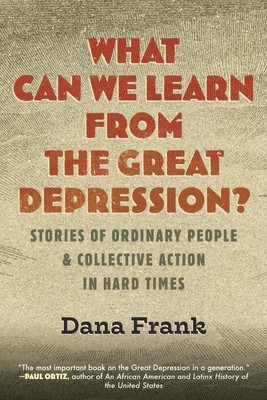
- We will send in 10–14 business days.
- Author: Dana Frank
- Publisher: Beacon Press
- ISBN-10: 0807046906
- ISBN-13: 9780807046906
- Format: 15.5 x 23.1 x 3.6 cm, kieti viršeliai
- Language: English
- SAVE -10% with code: EXTRA
Reviews
Description
Four stories of resilience, mutual aid, and radical rebellion during the Great Depression that change our understanding of the era and shed light on our own What Can We Learn from the Great Depression? draws on the voices of individual working people to tell the stories left out of standard histories of that era. Two chapters focus on inspiring, often audacious militance: One tells the story of seven Black women who worked as wet nurses selling their breast milk to the City of Chicago, who daringly staged a sit-down strike at City Hall to demand better pay and an end to racial discrimination. A second looks at the ways diverse people sought to meet their basic needs through mutual aid, cooperatives, eviction protests, or demands for government relief, in the process imagining and building alternative societies. Both these chapters challenge us to rethink what a labor movement might look like if it embraced both waged labor and women's labors in the home. A third chapter looks at the forcible expulsion of a million Mexicans and Mexican Americans during the Great Depression, and contrasts its erasure in our historical memory with the enshrinement of poor white migrants, often fictional. A final chapter looks closely at the Black Legion, a white supremacist fascist organization in the Upper Midwest among working-class white men (and a few women), whose members saw racism, anti-semitism, anti-Catholicism, and a fascist seizure of the state as the answer to the Depression. Collective action during the 1930s could mean protest against inequality and racism, but it could also mean finding new ways to blame and oppress others. Or it could mean new strategies to simply survive such hostilities. As its best, it meant powerful new forms of horizontal reciprocity and solidarity through which ordinary people sought to collectively provide the bread, beans, and comradeship of daily life. What Can We Learn from the Great Depression? helps us imagine how to address our own failed economy, and how to imagine and build movements challenging it that do not themselves replicate racism and patriarchy. And it helps us imagine what our own transformation of the state might look like, in service to the common good.EXTRA 10 % discount with code: EXTRA
The promotion ends in 23d.10:16:02
The discount code is valid when purchasing from 10 €. Discounts do not stack.
- Author: Dana Frank
- Publisher: Beacon Press
- ISBN-10: 0807046906
- ISBN-13: 9780807046906
- Format: 15.5 x 23.1 x 3.6 cm, kieti viršeliai
- Language: English English


Reviews